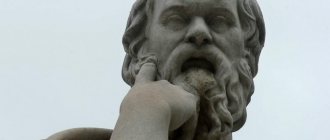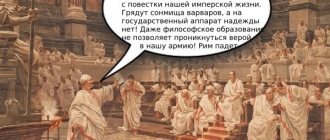Rhetoric in the Middle Ages
The main feature of the medieval era is its deep relationship with religion.
The main type of oratory for this period became spiritual eloquence.
Church ministers retell sacred dogmas and biblical legends.
The main method of influencing the listener is suggestion, not persuasion.
Homiletics is actively developing: the auxiliary science of theology explains church theory and introduces preaching literature.
Noteworthy are the works of the Spanish Archbishop Isidore of Seville and the Anglo-Saxon chronicler and monk the Venerable.
In their works, rhetorical terminology is clearly explained, and the material is systematized. The Church during this period is considered the largest feudal landowner. Everything was subordinated to theology: social institutions, philosophy, art, education.
With the advent of higher educational institutions, university eloquence appears. It is also closely connected with the church and is based on scholasticism. This philosophy relies entirely on religious authorities and neglects everyday experience.
John Chrysostom is considered one of the greatest writers of that time: he perfectly combines an ancient rhetorician and a Christian theologian.
He was considered the protector and patron of the weak and poor, as well as those whose work is related to oratory - teachers and lawyers.
Introduction
Oratory is the art of constructing and delivering a speech in public with the goal of influencing an audience. A similar interpretation of oratory was accepted in ancient times. Oratory is also called the historically established science of eloquence and an academic discipline that sets out the fundamentals of oratory.
In ancient times, rhetoric was considered as the science of argumentation in public speech, necessary when discussing practical issues. Later, rhetoric was borrowed by the Romans, adapted to the needs of Roman society and improved not only as a stable system of scientific concepts, but also as an educational subject.
In the XVII–XIX centuries. Rhetoric began to be understood as the science of argumentation primarily in written speech: the social importance of oratory at this time decreased, and the importance of written literature - theology, religious and political journalism, philosophy, historical prose, documents - increased. Private rhetoric is gradually developing, in which the rules for creating specific types of works are formulated - court speeches, sermons, letters, business papers, historical, philosophical, scientific essays, etc.
In the second half of the 19th century, rhetoric was excluded from the education system, and its place was taken by the compulsory study of artistic works and the opinions of literary critics on various issues of public life.
Modern neo-rhetoric brings a return to the heritage of Christian culture, taking into account modern scientific knowledge.
All European rhetoric is based on ancient rhetoric. The works of Aristotle, Cicero and other authors of the ancient world had a huge influence on those who created rhetoric in other countries, including Russia.
Rhetoric in the Renaissance
During the Renaissance, rhetoric received a new round of development. Business and parliamentary eloquence appears; judicial - is reborn. During the Renaissance, the emphasis is on human individuality.
The orator-philosopher Cicero becomes a role model. And although he was not an original thinker or the creator of his own philosophical system, the writer sought to introduce people to the latest events and provide material for meaningful reading and self-education. Rhetoric is closely intertwined with literature.
The personality of man and his freedom began to manifest themselves more clearly than ever in speech. People tried to discern rhetorical possibilities in their native language, relying on the impressive experience of ancient authors.
The fiction of that time strives to improve speech culture, enhances verbal sensitivity, tries to show the expressive capabilities of language and instills an aesthetic taste for the word.
A classic example of Renaissance oratory is the monologues of Hamlet, Juliet and other Shakespearean heroes.
Rebellious sermons are becoming popular in the church environment. The Italian monk Savonarola actively criticizes the Vatican and the luxury of the Catholic Church. And Jan Hus, holding the position of rector of the University of Prague, delivers his sermons in simple folk language and knows how to skillfully change the form of presentation of thoughts depending on the target audience.
The priest was considered a national hero of the Czech Republic. In his words people found justice and honesty. Hus carried out a reform of Czech spelling, after which books became available to the common classes.
Rhetoric is an integral part of the culture of any people. Thanks to this discipline, ideas and ideas for a particular historical society are affirmed.
At the same time, another important function is realized: rhetoric is a mediator between people and establishes mutual understanding between them.
Related posts:
- What is "War and Peace" about? Summary of the novel “War and Peace” by chapters. All answers...
- Rhetoric - traditional and modern Modern rhetoric - the origins of oratory. Rhetors of the times of Ramus and...
- Ancient Greek rhetoric The reasons for the emergence of the art of rhetoric in Ancient Greece. Its founders. Influence…
- Logorhythmic classes and correctional means By various means, speech therapy classes contribute to the effective correction of speech in children...
Ancient rhetorical ideal and culture of revival
In his famous anti-Averroist pamphlet of 1367, “On the Ignorance of His Own and Many Others,” Petrarch discusses the question to what extent a Christian is allowed to be a “Ciceronian.” The word “Ciceronianus” was shadowed by the reproachful words of Christ heard in a dream by Blessed Jerome almost a thousand years earlier: “Ciceronianus est, non Christianus”725.
“Of course,” Petrarch declares, “I am neither a Ciceronian nor a Platonist, but a Christian, for I have no doubt that Cicero himself would have become a Christian if he could have seen Christ or learned Christ’s teaching.”726
The conditional mode of the unreal assumption (if only the pagan classic could recognize the teachings of Christ, he would become a Christian) prompts us to recall the words of the late medieval Mantuan sequence about the Apostle Paul: “Having been taken to the tomb of Maro, he shed over it a dew of compassionate tears: “What,” said he, “I would have done you if I had found you alive, O greatest of poets.”727 In general, the need to posthumously baptize ancient authors is characteristically medieval728. Byzantine poet of the mid-11th century. John Mavropod, Metropolitan of the Euchaites, formally prayed in verse for the repose of the souls of Plato and Plutarch: “If You, my Christ, would deign to remove any pagans from Your condemnation,” his epigram reads in a literal translation, “take out Plato at my request.” and Plutarch! After all, both of them, in word and character, came closest to Your laws.”729 An example was set in the patristic era. In the time of Jerome, for his IV Eclogue, Virgil was often called “a Christian without Christ,” which, however, Jerome himself disapproved of730. Augustine, in one of his letters, reflected on whose souls, in addition to the Old Testament righteous, were brought out of hell by Christ - were they not the souls of the ancient pagans, especially those “whom I know and love for their literary works, whom we honor because of their eloquence and wisdom"; True, he still considered it rash to answer this question (from a theological point of view, much more daring than the modus irrealis of Petrarch and the Mantuan sequence). And another parallel to Petrarch’s “if” is the words of Lactantius about Seneca the Younger: “He could become a true worshiper of God if someone showed him the way”732. “Seneca is often ours,” Tertullian733 said, and the need to turn the unreal conditional period of Lactantius into a statement of fact gave rise, as is known, to the fictitious correspondence of the Roman Stoic with the Apostle Paul734, already known to Jerome735 and popular in the Middle Ages.
What's new in Petrarch's words? Maybe it’s worth paying attention not to the statement itself, but to whom this statement refers to?
In fact, Plato and Plutarch, for whom Mavropod prayed, are philosophers, and strictly idealistic philosophers, with a strong mystical pathos. Plato taught contemplation of spiritual reality and, as it were, anticipated many features of medieval sacred authoritarianism - starting with the utopia of the theocratic rule of “philosophers”, who resembled either Western doctores or Orthodox “elders”, to whom A.F. likened them. Losev736. Plutarch developed a mystical ontology in the dialogue “On EI at Delphi” and demonology, which greatly influenced medieval ideas, in the dialogue “On the Demon of Socrates,” and in his moral doctrine737 he really “approached the laws of Christ.” Seneca, of whom Tertullian and Lactantius spoke, is a moralist, like Plutarch; restless and divided in himself, he was clearly looking for some new foundations of morality. Finally, Virgil, who in the IV Eclogue announced the birth of the world Savior and the beginning of a new cycle of time, is the most mystical of the Roman poets. But Petrarch was not talking about a philosopher, not about a moralist, not about a poet, but about an orator, a politician, a lawyer - a lawyer first of all (“optimus omnium patronus”, “the most excellent universal lawyer” - that’s what his contemporary Catullus called Cicero). In comparison with Plato and Plutarch, Seneca and Virgil, Cicero appears as a man completely “of this world”, without mystical depths, who can evoke admiration, but not reverence - just as reverence is not felt in him.
This is how he was judged in quite different times. “As for Cicero,” notes Montaigne738, “I am of the opinion that, if we do not talk about learning, his spirit was not distinguished by height.” And Lactantius, who owed much to Cicero in literary terms and who himself earned the nickname “Christian Cicero” from humanists, wrote:
“In his essay on duties, Cicero says that you should not harm anyone, unless you yourself are hurt by an insult... Just as he himself practiced dog-biting eloquence, so he demanded that a person imitate dogs and snarl in response to an insult”739.
The lawyerly, judicial eloquence of Cicero is a “dog” for Lactantius, because he is eager to bite the enemy; the pragmatic and everyday mediocrity of the moral position of the Roman orator, opposed to Christian ethical maximalism, is expressively connected precisely with the fact that he is an orator and lawyer. What else can you expect from a lawyer if not a down-to-earth way of thinking!
To this it can be objected that for the era of Petrarch, unlike the era of Montaigne, partly from Lactantius’s, and even more so from ours, Cicero was not so much a solicitor, not so much a lawyer and politician, in general, not so much himself, Cicero, as a mirror, in in which they contemplated the still inaccessible, but so attractive Plato. Already Lactantius calls Cicero “our first imitator of Plato”740; but this still sounds not without irony. Less than a century after Lactantius, Augustine, for all his brilliant education, was not inclined to read Greek and thereby anticipated the linguistic isolation of medieval Latin culture, turned to philosophical, and through them to religious interests under the influence of Cicero’s dialogue “Hortensius”; recalling this in his “Confession,” he reproaches ordinary connoisseurs who praise Cicero’s language and do not notice his mind (pectus)741. “Plato is praised by the best authorities, Aristotle by the majority,” notes Petrarch,742 and in this context the “best authorities” (maiores) are primarily Cicero and Augustine. The cult of Cicero is taken from Petrarch in the same brackets as the cult of Plato and together with it is opposed to the cult of Aristotle - a combination so characteristic of the Renaissance as a whole and universal in its historical and cultural significance. So, let’s assume that Petrarch’s Cicero is “the first imitator of Plato,” the sage who led young Augustine to Neoplatonism, and ultimately to Christianity. Behind Petrarch are the authorities of Augustine and (with a reservation) Lactantius - again, a typical Renaissance appeal to patristics, that is, to Christian antiquity, against scholasticism. Everything seems to be falling into place.
However, with Cicero - the sage as a fact of Petrarch's consciousness - the situation is not so simple. To begin with, it was Petrarch in 1345, i.e. 22 years before the writing of the pamphlet “On the Ignorance of His Own and Many Others,” who opened the correspondence of Cicero in Verona and was amazed to see before him not a sage at all, but how as he himself put it, “an eternally restless and anxious old man,” who “chose constant struggle and useless enmity as his destiny”743. As for the authority of patristics, Lactantius, as Petrarch well knew, not only exposed Cicero in his insufficiently elevated approach to the problem of revenge and forgiveness. He, Lactantius, posed a question that was quite consonant with the criticism of Cicero as a thinker in modern and contemporary times: the question of the seriousness or frivolity of Cicero’s attitude towards philosophy as such. Lactantius's criticism begins from a comparison of two statements of the Roman orator. In the Tusculan Conversations, Cicero exclaims: “O philosophy, guide of life!” (“Ovitaephilosophiadux!”)744. But in one of his lost works it was said: “The dictates of philosophy must be known, but one must live according to civil custom (civiliter)”745. This transformation of the precepts of the “guide of life” into a subject of purely theoretical, purely intellectual awareness, not binding to anything, not interfering with living the same life as all other Roman citizens who are not philosophers live, evokes an energetic protest from Lactantius. “So, in your opinion, philosophy is exposed as foolishness and futility?”746 If philosophy does not transform our way of living, it is not a matter of life, but literature, and there is no reason to call it “the guide of life.”
But Cicero’s position, denounced by Lactantius, is not a product of thoughtlessness, but rather a thoughtful and consistent position; its very inconsistency (inconstantia, as Lactantius puts it) is consistent in its own way. His philosophy is philosophy under the sign of rhetoric, as he himself quite expressively speaks of this through the lips of Crassus in Book III of his dialogue “On the Orator”:
“Philosophy is not like other sciences. In geometry, for example, or in music, what can a person who has not studied these sciences do? Just be silent so that he won’t be considered crazy. And philosophical questions are open to every insightful and sharp mind, able to find plausible answers to everything and present them in skillful and smooth speech. And here the most ordinary speaker, even not very educated, but with experience in speeches, will beat the philosophers with this simple experience of his and will not allow himself to be offended and despised. Well, if someday someone appears who can either, following the example of Aristotle, speak for and against any subject and, according to his instructions, compose two opposing speeches for every matter, or, following the example of Arcesilaus and Carneades, argue against any proposed topic, and if he combines oratorical experience and training with this scientific training, then this man will be a true orator, a perfect orator, the only orator worthy of this name.”747
Cicero decisively annexes philosophy to rhetoric, subordinating it not so much to the professional needs of rhetoric as to the fundamental rhetorical attitude of the mind.
Therefore, it is so important that Petrarch, and after him the humanists, chose Cicero as their “leader,” patron and idol; that the question of Lactantius to Cicero is, in general, removed for them748. They are within Cicero's position.
What does this position look like in a broad historical perspective, with an eye to the very antiquity about which humanists thought so much?
The Greeks created not only their own culture - specific, historically unique, with its own specific characteristics and local restrictions; At the same time, in a dual creative process, they created a paradigm for culture in general. This paradigm, having renounced the Greek “soil” back in the Hellenistic era, and from the obligatory connection with the Greek language in Rome, remained significant for the Middle Ages, and for the Renaissance, and further, until the era of the industrial revolution749.
Significant is not the same as unchangeable. However, until the paradigm was abolished as a principle, all changes proceeded from it, were correlated, commensurate with it. We must clearly see the constant precisely in order to see the newness of the Renaissance.
The Greek paradigm has a very definite structure, and this structure is not similar to the image that stands behind the usual rubrication of our presentations of the general history of culture, including Greek, where “literature”, “art”, “philosophy” and “ science”, as points of a single questionnaire offered to different eras for completion.
What we call “culture”, the Greeks called παιδεία, actually “education”, that which is transmitted and instilled in the child, παις. At the center of παιδεία are two forces that are in constant conflict, but also in contact, in opposition, but also in mutual correlation: the education of thought and the education of the word - philosophy, seeking truth, and rhetoric, seeking persuasiveness. They are closer to each other than we imagine: they have a common root in the archaic mental and verbal culture, and even in the phenomenon of sophistry they demonstrated an inseparable unity750. That is why they constantly quarreled. Each of them sought to restore the inseparability of thought and word, truth and persuasiveness on its own basis, that is, to absorb its rival and absorb it into itself. Philosophy claimed that it was, along with all the others, the “true” rhetoric: hence the rhetorical studies of Aristotle, the Stoics, and the Neoplatonists751. Rhetoric claimed that it, and only it, is the “true” philosophy: we have already seen that for Cicero, a true orator and a true philosopher are one and the same, and among the representatives of the Greek “second sophistry” of the 2nd-4th centuries. we find many similar declarations. In other words, both philosophy and rhetoric are not parts of the culture of the ancient type, not its “provinces” and “domains”, which could be demarcated and each could peacefully exist within its own boundaries, perhaps entering into light border disputes. No, the ancient type of culture gives both philosophy and rhetoric the opportunity to simply identify themselves with culture as a whole, to declare themselves the principle of culture. The face of culture is twofold: it is “paideia” under the sign of philosophy and “paideia” under the sign of rhetoric. Duality is inherent in the very basis of the cultural warehouse created by the Greeks and is reproduced along with this warehouse itself. The victory of the “arts” over the “authors” in the transition from the 12th to the 13th centuries, the revenge of the “authors” in the speech of humanists against scholasticism, the dispute between Pico della Mirandola and Ermolao Barbaro - all these complex events in the history of ideas, each of which has its own ideological content, fit into the framework of the old conflict between philosophy and rhetoric, although, of course, they cannot be reduced to this dispute.
So, philosophy and rhetoric are the very heart of culture of the ancient type, and in this heart lives a resurgent contradiction. But fine art, which for us is undoubtedly included in the concept of “spiritual culture,” the Greeks would have hesitated to include in the concept of their παιδεία. According to the well-known remark of Plutarch, not a single “capable” young man (“capable” of what? - of course, for activities in the sphere of mental and verbal culture or in the sphere of civil life), admiring the masterpieces of Phidias and Polykleitos, would himself want to be neither Phidias nor Polycletus752. It is curious that in Lucian’s autobiographical work “On Dreaming, or the Life of Lucian,” the personification of Ερμογλιςική τέχνη (“the craft of a sculptor”) is contrasted with παιδεία. The first refers in her speech to the names of Phidias and Polykleitos, Myron and Praxiteles753; but only the second represents “culture” (in Lucian’s context, rhetorical culture).
It was at this point, as we know, that the Renaissance departed far from antiquity.
Even Petrarch thought in the ancient (and medieval) way: representatives of any “handicraft”, any τέχνη, “mechanici”, are excluded from culture, from the world where there are books. “What will happen,” he exclaims pathetically in the same pamphlet, “if manual workers (mechanici) take up their pens (calamos arripiunt)?”754 Every philosopher, every poet, every learned man must protest against such a terrifying prospect. Vestra res agitur!
To appreciate the revolution produced by the Renaissance, it is enough to compare the place occupied by Vitruvius - also a mechanicus, who took up the pen! – comparatively in the culture of his own time and in the culture of modern Europe from Alberti to Vignola and beyond755.
The same is the contrast of tone in which the names of painters, sculptors and architects are introduced in ancient texts on the history of art - and, say, in Vasari (whose work in other respects provides a fairly close analogy to these texts756). For example, Pliny the Elder, who speaks very respectfully of artists on an ancient scale, begins his biographical columns this way: “...In the ninetieth Olympiad lived Aglaophon, Kephisodorus, Friel, Evenor...”757, “...He entered the now open gates of art in the fourth year of the ninety-fifth Olympiad Zeuxis from Hercules..."758; “...His peers and rivals were Timanthos, Androcydes, Eupompus, Parrhasius...”759; “...Parrhasius, born in Ephesus, did a lot there...”760 Pliny states that all the painters who were, are and will be surpassed by Apelles761, as well as all sculptors by Phidias762; this seems to be said quite strongly, not without rhetorical pathos, but it only marks the superiority of a certain person in a certain type of activity, and in no way the superiority of this type of activity itself among others. The appearance of Apelles or Phidias is an event in the fate of art; It does not follow from anything that this is an event in the destinies of mankind. On the contrary, Vasari describes Michelangelo’s appearance not simply as a triumph of art, but as a reconciliation of heaven and earth, God and people: “The most benevolent Ruler of heaven turned His compassionate eyes to earth”763. This quasi-theological tone is very characteristic of Vasari: for example, Leonardo da Vinci was, in his words, “truly wonderful and heavenly (celeste)”764.
In this regard, the use of the epithet divinus - “divine” is important. In ancient usage, this epithet was normally applied to famous masters of the art of speech. For Cicero, for example, Servilius Galba is “divine in speeches” (divinus homo in dicendo)765, and Crassus is even “god in speeches,” at least according to the judgment of Quintus Mucius Scaevola, one of the participants in the dialogue766; Cicero pathetically recalls Crassus’ last speech in the Senate as “the swan speech of the divine man” (cycnea divini hominis vox et oratio)767. The eloquence of Cicero himself is “divine” in Quintilian’s assessment768; “divine” is the irony of Cicero’s speech “In Defense of Ligarius”769; the same Quintilian speaks of “the divine splendor of Theophrastus’s speech”770. The “divine” orator and the “divine” poet (the latter, for example, in Horace771) stand next to the “divine” sage772 and the “divine” Caesar773; but the “divine” artist next to them is invisible, he is not visible. Things would be different at the end of the Renaissance. Even during Michelangelo’s lifetime, everyone was so accustomed to calling him “divine” that Aretino can already play with this cliché in his well-known letter to Buonarotti dated November 1545, where, after a stream of reproaches and denunciatory hints, he suddenly conciliatoryly concludes: “I just wanted to show you , that if you are “divine” (divino – di vino – “wine”), then I am not “watery” (d’acqua)”774.
The ancients wrote epigrams about works of art in abundance - but, as a rule, not about the artists themselves. In the “Palatine Anthology” there are 42 epigrams on Myron’s “Cow” and 13 epigrams on Praxiteles’ “Aphrodite Anadyomene” - but not a single epigram on Myron or Praxiteles! And now, during the Renaissance, Poliziano himself, the first poet of the Quattrocento, composes an epigram for Giotto’s tomb in Santa Maria del Fiore, beginning with the words:
Ille ego sum, per quern pictura extincta revixit…
(“I am the one through whom faded painting came to life”775)
One must feel all the incomparable weight and solemnity of the Latin ille in order to appreciate such a beginning, which repeats at least two famous beginnings: firstly, the apocryphal, but at that time attributed to Virgil, lines that precede the Aeneid:
Ille ego,
qui quondam gracili modulatus avena Carmen, et egressus silvis vicina coegi Ut quamvis avido parerent arva colono, Gratum opus agricolis...776;
secondly, the opening words of Ovid’s poetic autobiography:
Ille ego qui fuerim, tenerorum lusor amorum…777
A poet could talk about himself like that in ancient literature, but it was “out of rank” for an artist. Now the proud Ille ego is pronounced on behalf of the artist.
Here we have a chance to grasp an important detail: the lexical series applied to artists since the Renaissance is taken from the ancient practice of praising poets and especially rhetoricians. (For antiquity, a rhetorician is often superior to a poet: Cicero could have called poetry, in comparison with rhetoric, “a more lightweight form of verbal art”! 778) The opportunity to call himself “Ille ego” passes to the artist from the poet; the epithet “divine” comes to him primarily from the speaker. Without the “divine” Aelius Aristides and the “divine” Libanius, the “divine” Cicero and all the others, the “divine” Michelangelo would not have been possible. The deification of the rhetorician served as a primary precedent for the deification of the painter, sculptor, and architect.
In this regard, it is worth noting that the comparison of painting, sculpture and architecture with oratory was quite conscious and fundamental for the Renaissance. According to Aeneas Silvia Piccolomini, “these two arts, eloquence and painting, love each other mutually”779.
According to old memory, in obedience to the ancient tradition, the arts that deal with material objects and are therefore not “free” are subordinated to the “free” arts and, above all, to rhetoric. But this subordination is friendly, intimacy is preserved in it, and the moment of intimacy is more important than the moment of subordination. “The arts that come closest to the free ones are the arts of painting, sculpture in stone and bronze and architecture,” says Lorenzo Balla in the preface to his “Beauties of the Latin Language”780.
The description of the internal division of the plastic arts is adapted, adapted to rhetorical schemes. In this sense, the remark of Ludovico Dolci, which already belongs to the post-Renaissance era (1557), is characteristic: “The entire sum of painting, in my judgment, is divided into three parts: Location, Drawing and Color (Invenzione, Disegno e Colorito)”781. One cannot help but remember that since ancient times the work of the orator has been divided into Inventio, Dispositio et Elocutio.
This convergence of manual art and rhetorical culture corresponded, as is known, to a new type of person specific to the Renaissance, who in his own person combined literature and the pursuit of painting, sculpture and architecture: the humanist as an artist and the artist as a humanist.
A classic example is Leon Battista Alberti, a man, as Vasari characterizes him, of “the most refined and excellent morals,” who “lived as befits a man of high society” (onoratamente e da gentiluomo) and mastered verbal culture (lettere)782.
Now let’s try to ask ourselves the question: where in the ancient tradition do we find an approximation to this, generally speaking, non-antique ideal of a sophisticated person, far from the “low” habits of a professional, living da gentiluomo, but at the same time able to do “everything” on his own; an adept of verbal and mental culture – and a jack of all trades (emphasis on the word “hands”)?
We find it in the region of so-called sophistry, that is, in that zone which is most obviously subject to the supremacy of rhetoric.
Apuleius, Roman sophist of the 2nd century. n. e., praises Hippias, his Greek brother, who lived six centuries before him, because he, inferior to no one in eloquence (eloguentia), surpassed everyone in the variety of his skills and abilities (artium multitudine). He tells how Hippias once appeared at the Olympic Games in a magnificent outfit, made from start to finish with his own hands; and the Hellenes, who gathered from everywhere for the games, marveled at this, along with his learning and ornateness. The subject of amazement is the studia varia, the diversity of interests and activities of Hippias783. Here is the prototype of the Renaissance uomo universale. We will not find a closer prototype.
If any of the ancients spoke about the plastic arts in a serious and even enthusiastic tone, it was not the ancient philosopher, but the ancient sophist of the late era, a representative of the second sophistry. It is impossible to imagine, for example, that Aristotle, who seemed to write about everything in the world, would speak about sculpture and painting as he did about epic and tragedy in Poetics and about eloquence in Rhetoric. It is even more impossible to imagine some kind of ancient correspondence to Schelling’s “philosophy of art.” The highest and most significant thing that has been said in all of antiquity about a plastic masterpiece is the words of Dion Chrysostomos, one of the founders of the second sophistry, about Phidias’ statue of Zeus784. Here the artist is described as a teacher and educator of humanity, its “legislator”, and not only. sweetener
It is curious that the most striking exception in the philosophical literature of antiquity is in Plotinus, by the way, a favorite of the Renaissance: this is his thesis about the intelligible example of the same Phidias Zeus785. But something else is also curious: this thesis is found verbatim before Plotinus in philosophizing rhetoricians - Cicero786 and the same Dion787.
The verbal and mental assimilation of the colossal phenomenon of ancient art took place to a large extent in the sphere of late antique rhetorical ekphrasis,788 which found so many echoes in the culture of the Renaissance.
Generally speaking, for antiquity, the above statement of Aeneas Silvius Piccolomini about the mutual love of rhetoric and painting justifies itself. They were united by: 1) the status of τέχνη in contrast to έπιστήμη, i.e., an attitude towards credibility, and 2) the moment of hedonism, so suspicious for all ancient philosophical thought, including even Epicureanism, which was concerned with the minimization of human needs.
Respect for the painter, sculptor, and architect as a “divine” person entered the structure of culture of the ancient type during the Renaissance, entered as something new, which did not exist before; but it entered through an old door - the door of the rhetorical ideal.
Returning to the image of Hippias in Olympia, it should be noted that the ideal of the uomo universale, so characteristic of the Renaissance (and slightly euphoric), a person who knows everything, can do everything, tries himself in everything - the ideal expressed in Pantagruel's training program - is rhetorical ideal. Philosophy knew, of course, the propaedeutic sciences: Plato forbade entry into the Academy to anyone who had not studied geometry. Philosophy could provide a methodological impulse and a program for collecting and processing facts in the most diverse fields of knowledge: this was the case with Aristotle and the Peripatetics. But the philosopher is almost the antipode of uomo universale; his business is depth, not breadth: “much knowledge does not teach intelligence,” as Heraclitus said.
A rhetorician is a completely different matter. How energetically Cicero insists through the mouth of Crassus789 that an orator must be able to talk about everything! “I drank in Athens from other cups,” Apuleius boasts, “from the cup of poetic invention, from the bright cup of geometry, from the tart cup of dialectics, but especially from the cup of all-encompassing philosophy - this bottomless cup of nectar. And in fact: Empedocles created poems, Plato - dialogues, Socrates - hymns, Epicharmus - music, Xenophon - historical works, Crates - satires, and your Apuleius tries his hand at all these genera and works with equal zeal in the field of each of the nine muses"790. For a rhetorician is an amateur in the highest sense of the word; his work is not “one”, but “all”, not self-concentration, but the self-development of the personality, not its systole, but its diastole.
When it comes to the Renaissance ideal of uomo universale, it is difficult to avoid such a topic as “the dignity and superiority of man,” dignitas et excellentia hominis. And here we can once again see how precisely rhetoric was the instrument through which the Renaissance defined and asserted itself in the face of the past.
Indeed, rhetoric is the art of praise and blasphemy, “encomia” and “psogosa”; such an approach to all things in the world is an integral feature of a rhetorician.
As you know, in 1195, Cardinal Lothair, the future Pope Innocent III, wrote a treatise “On the Misery of the Human Condition” - an ascetic work as opposed to the spirit of the Renaissance as anything can be opposite to it. However, Lothair intended and formally promised to write another WORK to encourage the humble - this time about the dignity of man. He did not have time to fulfill his promise: three years later he was elected pope, and he no longer had time for literary leisure. “On the Dignity and Superiority of Man” was written by other, completely different people - the humanists Gianozzo Manetti (1452) and Giovanni Pico della Mirandola (1487).
Of course, even if Lothair had written a second treatise, he would have seen the dignity of man with completely different eyes than his historical opponents. It is also important, however, that in the rhetorical space “psogos” itself posits the possibility of “encomia”, “blasphemy” - the possibility of “praise”. Lothair created a “blasphemy to man”, Manetti and Mirandola - “a word of praise to man”: this is a very sharp ideological and general cultural contrast, but at the same time it is a movement that does not leave the same plane. The inversion of “blasphemy” easily gives “praise”; but, unfortunately, turning back 180° is also easy. “What a miracle of nature man is! – Hamlet exclaims in the second act. - How noble in mind! With what limitless abilities! How precise and amazing in appearance and movements! In actions how close to an angel! How close to God he is in his views! The beauty of the universe! The crown of all living things! What is this quintessence of dust to me?”791 “The beauty of the universe,” “the crown of all living things” is a normal topic of praise. “The quintessence of dust” is a normal topic of rhetorical censure. Together they create a vicious circle.
Only Pascal, in his discussion of the greatness and insignificance of man as a single
reality and a single theme for thought breaks this circle and goes beyond the mechanical juxtaposition of “praise” and “blasphemy.” Thus began a new world in which we still live.







